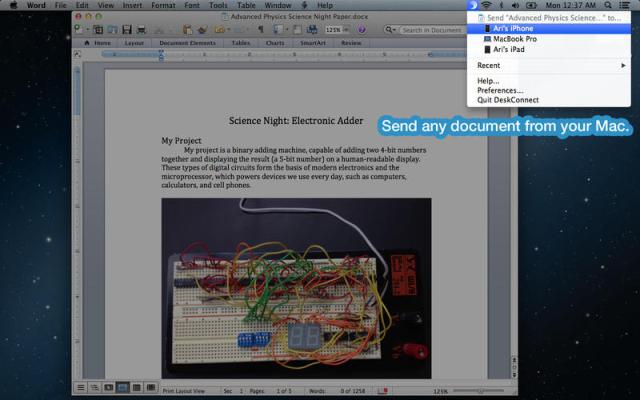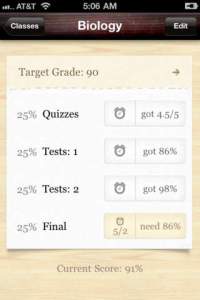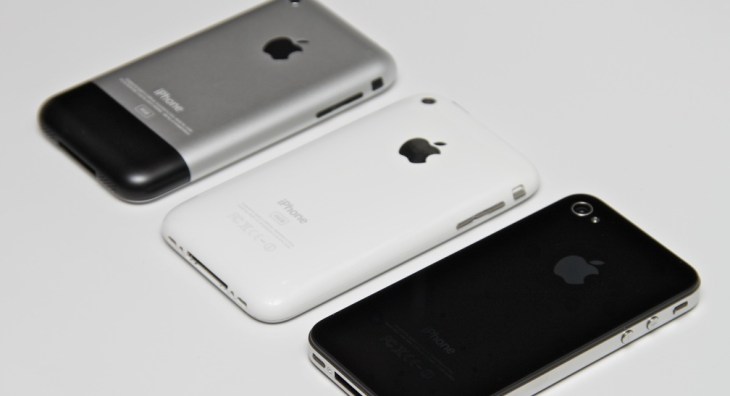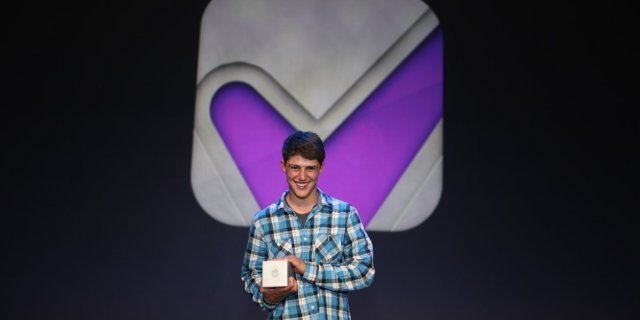“This is going to sound a little odd,” Ari Weinstein says, “but when I was a kid coding…was a lot harder.”
Ari Weinstein is just 19. He’s about to start as a freshman at MIT after deferring for a year to do a little fooling around. And he’s been playing in Apple’s ecosystem — in one form or another — since he was 11. That was when he took an interest in the iPod Linux project and created an easier way to install the open-source operating system on Apple’s music player.
Weinstein is just one of a growing group of young developers that are choosing Apple’s iOS platform, and specifically the iPhone, as the place where they cut their teeth. These young coders and designers use the iPhone from a young age and — when they get the urge — begin hacking and noodling on them. Eventually, they graduate to publishing apps, some garnering attention and awards from Apple.
Young developers are already working on the apps that will end up on our home screens. And those apps aren’t simple student projects, they’re award winners that are well designed, well executed and well received. This is what the next generation of top developers who will be building the apps for everything in your life looks like — and they’re building for iOS.
Android has long had a reputation for being difficult to design and develop for, but Google has done a lot to change that reputation over the last couple of years. It continues to introduce better tools for developers and its market-share is becoming a draw that many feel they can’t ignore. And there has been a surge of developers and designers like Paul Stamatiou who are ‘discovering’ the platform and beginning to evangelize it.
But the fact remains that some of the best young developers in the world prefer iOS and if Google wants to capture the hearts and minds of the coming generation of touch-interface craftspeople, then it needs to start young.
Hacker to Hyped
The interest in hacking and extending Apple’s hardware set Weinstein up nicely to get involved with the iPhone when it popped onto the scene in 2007. With no native SDK or App Store, it was up to those with the desire and skills to crack the iPhone’s system partition to give everyone the ability to play in its normally off-limits playground.
After developing the extremely popular iJailbreak tool out of his efforts to open up his iPod touch, Weinstein eventually became a part of the Chronic Dev Team — one of the major forces in the iPhone jailbreak community. That’s when Weinstein and the other members of the team released a jailbreak for the iPhone 3GS, a little under a month after its release. Millions of people visited the site within the first couple of days.
Now, four years later, Weinstein has released an app on the App Store called DeskConnect. It’s a way for you to transfer items from your iPhone to your Mac and vice versa.

And, though I have reason to believe that Apple knows exactly who Weinstein is and where he got his start, it has featured the app on the Mac store and placed it in the ‘new and noteworthy’ section of the iOS store. Why? One reason is that it’s a genuinely useful app that has already made its way into my daily workflow.
DeskConnect came out of a LinkedIn Intern hackathon after Weinstein found himself frustrated about how hard it was to move files and URLs between his phone and computer. He built the app and partnered with frequent collaborator Ben Feldman and designer Jay Moon — a freshman at Stanford — to release it on the store.
The app is basic, but reliable, with a quick and clever system that sends your file to an intermediary server and then transfers it post-haste to any other instance of DeskConnect. That includes an iPhone app and a Mac menu bar icon. After experiencing some transfer delays initially — which Weinstein says are largely due to the servers being crushed by initial attention — it’s been cruising along quite well for me.

There’s a general adage that developers prefer to create for the platforms that they use, and that holds true in the case of DeskConnect. Would Weinstein have created this app if he hadn’t been hooked early by iPod hacking and continued on with the iPhone? By his own admission, he’s always ‘loved iOS and the iPhone’ and wanted to create things with it.
So, perhaps he would have written the app anyway, but the early infatuation with Apple’s hardware guaranteed that it strengthened Cupertino’s ecosystem, rather than anyone else’s.
Oh, and that fooling around Weinstein was doing before MIT? Working out west for a WiFi startup as an intern. After 30 days as a grunt, the startup liked his work so much that they offered him a position and he stayed on for the rest of the year.
Award Winners
The Apple Design Awards have been something of an icon among aspiring developers for years now. The award, which is symbolized by a smooth block of aluminum that features a subtly glowing Apple logo, has marked software that Apple feels is an example of what it wants developers in its ecosystem to build The ADA can be awarded to products that are beautiful to look at — or that are cleverly made — and is often used to bless apps that utilize Apple’s latest and greatest OS X and iOS features.
Ryan Orbuch won his first ADA this year — at age 16 — for his app Finish. Shipped under the Basil Ltd mark and designed in conjunction with his partner Michael Hansen, the app hit #1 on the productivity charts in under a day and featured in the App Store by Apple.
“I think it was general [user experience] familiarity and really valuing the quality of UX,” says Orbuch of why Basil went to the iPhone for its premiere app. “I’d used an iPhone/iPod Touch for a while, and felt like I had a sense of, and really liked, the HIG [Apple’s design document that guides developers –ed] in general.”
“When I first conceptualized the sliding timeframe concept that would become Finish, I inherently thought about how it would work on an iPhone screen—it was just completely obvious. I never really considered anything else because of that familiarity, and the fact that everything would run perfectly on iPod Touch without any extra work is great too—iPod touches are huge with high schoolers, even though we’ve moved far beyond that now.”
“There wan’t really a ton of “decision” to it up front,” he says. “It was just like, ‘obviously iOS, why wouldn’t we?'”
Orbuch also touches on why they didn’t go to Android. He cites very little experience using it and the difficulty of predicting how apps will run on a variety of devices.
“Looking back now, I think I shied away from Android because it just felt like too much of a black box. Besides hardware fragmentation and all that that there’s a bunch written about, I had very little experience using it and just wouldn’t have really known where to start, and there wasn’t the assurance of consistency in experience on everyone’s phone.”
Orbuch acknowledges that there is a massive audience for Android, but notes that the testing procedures for making sure that Finish would work properly on the wide range of devices would have been prohibitive for the two-man team.
“If something has a huge install base but you can only be confident that you can create great UX on a tiny percentage of that install base, the overall size is totally irrelevant—something I think is often ignored when saying how big Android’s numbers are.”
In addition to the benefits of a focused array of devices that may not be as intimidating to new developers, the App Store also offers an unprecedented level of distribution for independent developers. They’ve always had the web, but there’s an insane amount of power in the App Store’s ability to funnel an audience — and importantly for sustainability, a paying audience — to apps from small teams.
Orbuch also credits the fact that you can go live in nearly two hundred countries with minimal effort on the developer’s part as a prime benefit of the App Store. That kind of global distribution was difficult to achieve previously due to the complexity of payments and security. “Sure, there are plenty of frustrations re review guidelines, rejection, time for approval, etc,” he says. “To us, though, those are relatively minor annoyances…without a centralized store, there’s no way any of this could have happened.”
And Basil isn’t the only studio that’s found acclaim on the App Store. Jeremy Olson is the founder of Tapity, an app studio that builds for others and markets its own apps on the App Store. Olson is also the recipient of an Apple Design Award, for his work on the app Grades 2, which was given the honors in 2011. Olson dreamed up the idea for Grades, a calculator for necessary test scores, when he was a sophomore at UNC Charlotte. 
“When Steve Jobs announced the iPhone, I knew or a fact this was the future,” says Olson. “I was big into PDAs as a kid and even helped a fellow design an art app for the Palm pilot when I was like 13. After Apple announced the iPod, I knew they wouldn’t stop at music. They had to make the ultimate PDA. With the iPhone, they did that and more. I was instantly sold.”
Android was also considered and discarded by Olson “because Apple, more than any other company, has taste. Their culture revolves around great user experience. That’s the kind of culture I wanted to be part of.”
Though he isn’t against Android, he says that several things prevent him from developing for the platform. Those include the fact that, in his opinion, Android doesn’t have the design-focused culture and tight-knit community that iOS does. Android, he feels, has also made it difficult to release successful paid apps with business models other than advertising. And, once again, he doesn’t use an Android device because he feels Apple’s product is superior.
Olson credits the web for his first taste of being able to build things and get them out where people could use them right away, but says that the App Store changed a lot for the business. “The problem on the web was distribution and getting people to pay for stuff, which is a big reason the App Store appealed to me,” he says. “Millions of credit cards [are] ready to pay for good products.” 
“The iPhone is a perfect place for young developers,” he says. “The App Store is a marketplace where my apps can compete and win against bloated competition from bigger companies. The Apple developer community is small enough that you can get to know most people in a year or two online and at conferences like WWDC — which offers a great scholarship for students, by the way.”
Because Apple fosters a strong focus on user experience, many developers are positive about the way that the App Store treats ‘standout’ apps.
“All you need to do is build a great experience and have a little initiative to go out and get to know the influencers in the community and you can start to release successful apps,” says Olson. “The community is so great. We are all in this together and constantly help each other build more successful apps.”
Ryan Orbuch also credits the distribution method and exposure of the App Store with the success of Finish so far.
“The centralized distribution that you don’t really have with web gives a lot of scale potential if you can make something truly quality, and the overall meritocratic nature of how apple features apps — plus the amount of visibility that a feature can give helps to reinforce that,” says Orbuch. “Finish has been featured a bunch of times, and it’s the ultimate in credibility—it’s an empirical, inarguable thing thats especially huge at this age.”
Challenges Ahead
That being said, there are still many challenges for the App Store waiting in the wings. For one, regardless of the success that some have had, discoverability remains a problem. Apple is still tweaking App Store rankings to better surface ‘deserving’ apps, but thousands more are added every week and there are no signs that finding good ones among the bad will get any easier.
Developer education is also at the forefront of the battle when it comes to Apple ensuring that there will continue to be talented young developers that use its platform.
“There is room for better ways for kids to learn programming,” says Ari Weinstein. He acknowledges sites like Codecademy, PeepCode and others. And, indeed, MIT has its own Open Courseware resources which offers basic programming instruction. But, says Weinstein, there is a serious lack of programs that connect the dots between basic programming skills and actually building a complex app.
There’s still a lot of room for programs that fill the gap between those basic skills and ‘how to put it all together’ in app form.
“Programming, even outside of apps, is a great skill,” Weinstein adds. “Even if you’re not using it for computer science. So many problems in the world can be solved with technology…I’m really interested in that.”
Olson agrees that there is a lot to learn, and that it isn’t a light job.
“Learning to code for the iPhone was by no means easy coming from a web development background. It took two failed attempts before I was able to finally break through and learn it,” he says. “The idea of Grades was what motivated me to finally buckle down and learn it. It took a good four months to get comfortable with the platform.”
“But as a whole,” he says, “Apple has such great developer tools and resources. They also pour lots of time into their Human Interface Guidelines to help make great interfaces too.”
And, he adds, “the opportunity is so vast to those who are willing to learn the stuff and put in the work.”
There is a massive opportunity here for Apple, and for competition like Google, to foster the next generation of developers with better education programs and learning tools. Apple already offers student scholarships for its developer conference and extensive online guides, but a true ‘school for developers’ would be an enormous feather in its cap. And it would help solidify it as the platform of choice for young developers obsessed with producing high-quality work.
Growing up iPhone
I’ve written before about growing up with touch interfaces, and how the next generation of users will be comfortable moving beyond the basic conventions that most of us are just getting used to. But it goes beyond the consumers, it’s also about the next generation of builders. The iPhone and the App Store democratized and accelerated independent software publishing in a massive way. It put college students and hackers on (relatively) even footing alongside giants of software like Microsoft or Google.
A distribution platform with an audience as large as the App Store is a pretty incredible tool for these developers. Especially when you consider that when I was 15 the Internet had roughly 40 million users, and Apple just announced that 600 million iOS devices had been sold in total. Each one with access to the App Store.
Web proponents will no doubt point out that it was the original indie platform, but the App Store educated customers on software and made them comfortable paying for it with a tap. Just as Amazon made shopping online a comfortable household activity — Apple did the same with the App Store.
Google has also made concerted efforts to approach and include young developers with its Code-in contests and offers an array of scholarships in conjunction with schools and other organizations. And it’s good that it is also taking fostering young developers seriously, because it’s the next generation of coders growing up using these devices that will shape the future of its platform, as they have already begun to do for Apple’s.
Image Credit: Yutaka Tsutano/Flickr CC

